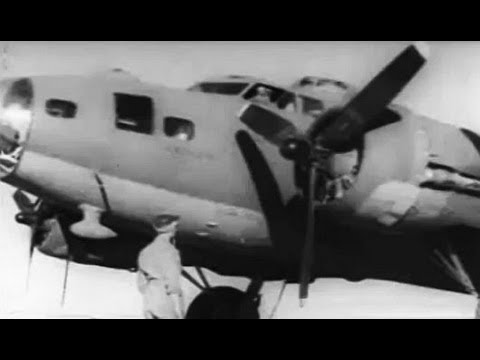more at
“Military training film in which an instructor takes a new B-17 bomber pilot through preflight inspections of the aircraft and preparation for departure.” Your instructor is Hollywood actor Arthur Kennedy, who made numerous World War II Army Air Forces training films.
NEW VERSION in one piece instead of multiple parts, and with improved video & sound:
see also:
How to fly the B-17: Flight Operations
The Story of the Flying Fortress
Fortress of the Sky
Public domain film slightly cropped to remove uneven edges, with the aspect ratio corrected, and mild video noise reduction applied.
The soundtrack was also processed with volume normalization, noise reduction, clipping reduction, and/or equalization (the resulting sound, though not perfect, is far less noisy than the original).
The Boeing B-17 Flying Fortress is a four-engine heavy bomber aircraft developed in the 1930s for the then United States Army Air Corps (USAAC). Competing against Douglas and Martin for a contract to build 200 bombers, the Boeing entry outperformed both competitors and more than met the Air Corps’ expectations. Although Boeing lost the contract because the prototype crashed, the Air Corps was so impressed with Boeing’s design that they ordered 13 more B-17s for further evaluation. From its introduction in 1938, the B-17 Flying Fortress evolved through numerous design advances.
The B-17 was primarily employed by the United States Army Air Forces (USAAF) in the daylight precision strategic bombing campaign of World War II against German industrial and military targets. The United States Eighth Air Force based at many airfields in southern England, such as Thorpe Abbotts airfield and the Fifteenth Air Force based in Italy – with many units stationed at the existing bases surrounding Foggia – complemented the RAF Bomber Command’s nighttime area bombing in Operation Pointblank to help secure air superiority over the cities, factories and battlefields of Western Europe in preparation for Operation Overlord. The B-17 also participated to a lesser extent in the War in the Pacific where it conducted raids against Japanese shipping and airfields.
From its pre-war inception, the USAAC (later USAAF) touted the aircraft as a strategic weapon; it was a potent, high-flying, long-range bomber that was able to defend itself, and to return home despite extensive battle damage. It quickly took on mythic proportions, and widely circulated stories and photos of B-17s surviving battle damage increased its iconic status. With a service ceiling greater than any of its Allied contemporaries, the B-17 established itself as an effective weapons system, dropping more bombs than any other U.S. aircraft in World War II. Of the 1.5 million metric tons of bombs dropped on Germany and its occupied territories by U.S. aircraft, 640,000 tons were dropped from B-17s.
As of September 2011, 13 airframes remain airworthy, with dozens more in storage or on static display…
Of the 13 YB-17s ordered for service testing, 12 were used by the 2nd Bomb Group of Langley Field, Virginia, to develop heavy bombing techniques, and the 13th was used for flight testing at the Material Division at Wright Field, Ohio…
As the production line developed, Boeing engineers continued to improve upon the basic design. To enhance performance at slower speeds, the B-17B was altered to include larger rudder and flaps. The B-17C changed from three bulged, oval shaped machine gun blisters to two flush, oval-shaped machine gun window openings and a single “bathtub” machine gun housing on the lower fuselage. Models A through D of the B-17 were designed defensively, while B-17E was the first model primarily focused on offensive warfare.
The B-17E was an extensive revision of the Model 299 design: The fuselage was extended by 10 ft (3.0 m); a much larger rear fuselage, vertical tail fin, rudder, and horizontal stabilizer were added to the design; a gunner’s position was added in the new tail; the nose (especially the bombardier’s well-framed nose glazing) remained relatively the same as the earlier -B through -D versions had, but with the addition of an electrically-powered manned dorsal gun turret just behind the cockpit, and the similarly-powered Sperry manned ventral ball turret just aft of the bomb bay… resulted in a 20% increase in aircraft weight. The B-17’s turbocharged Wright R-1820 Cyclone 9 engines were upgraded…
The B-17F variants were the primary versions flying for the Eighth Air Force to face the Nazis in 1943…

